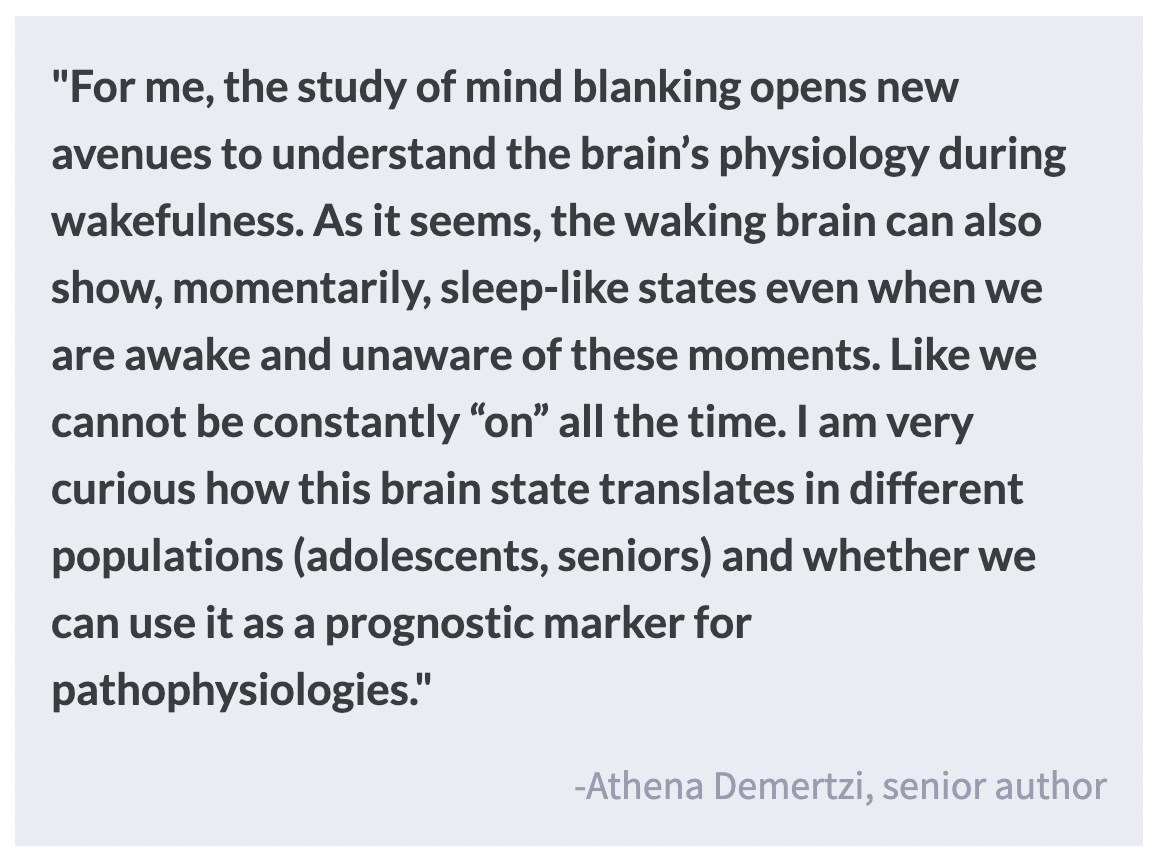The Neural Signature of Mind Blanking
Post by Lani Cupo
The takeaway
Occasionally while we are awake, our minds seem to go “blank”; we cannot say what we were thinking about. Mind blanking is a state that occurs by default, is characterized by a unique behavioral signature, and is linked to an underlying pattern of brain activity.
What's the science?
In recent years, an increasing number of studies have examined the phenomenon of mind blanking, examining the frequency of “zoning out” compared to other mental states, and characterizing the activation of brain regions during mind blanking. However, despite a growing body of research, the physiological and behavioral processes underlying this state remain inconclusive. This week in PNAS, Mortaheb and colleagues used functional magnetic resonance imaging (fMRI) data to characterize the dynamics of brain activity associated with mind blanking.
How did they do it?
Data were previously acquired from 36 healthy adults (27 women, 9 men) who were at rest (resting quietly) in the MRI scanner with their eyes open to ensure they did not fall asleep. A sound played randomly fifty times throughout the scanning period, prompting the participants to respond with a button to report whether their current mental state was one of four options: mind-blanking, perceiving sensory stimuli, thoughts related to external stimuli (stimuli-dependent), or thoughts independent of external stimuli (stimuli-independent). To characterize the behavioral profiles of mind blanking, the authors examined how frequently it was reported, whether the response time (speed to bush button after the auditory cue played) differed based on the reported state, and the probability to re-report mind blanking multiple times in a row.
To characterize brain activity during the mental states, the authors analyzed a 10-second window around each probe (each auditory stimulus prompting a response). First, they measured the amplitude of the global signal - a physiological proxy of arousal. To do this, the mean absolute value of the signal amplitude for each window is calculated across all regions of interest in the brain, giving a gross estimate of brain activity. Then, to determine whether the functional connectivity of the brain during mind blanking differed from other states, the authors trained a machine learning algorithm to classify participants' reports into different categories based on functional connectivity alone.
Finally, the authors used a clustering technique to derive four different patterns of connectivity over the entire resting state period and examined whether one of the four patterns was more strongly associated with the patterns of connectivity during mind blanking states.
What did they find?
First, the authors replicated results from previous studies reporting a low frequency of mind blanking compared to other mental states. Additionally, mind blanking was reported relatively fast compared to stimuli-dependent and independent states, potentially implying that content-less states were easier to recognize and report than states with content. It was extremely rare for participants to re-report mind blanking multiple times subsequently, which may suggest mind blanking reflects a transitional state between other states.
Second, there was a subtle difference between the amplitude of the global signal between states, with a slightly higher average signal amplitude in mind blanking than in stimuli-dependent or independent states. Global signal amplitude has been negatively correlated with alertness before, suggesting global silencing during wakefulness. This is consistent with these results which report a high global signal during an attentional lapse.
Third, the authors found that the trained machine learning classifier could accurately separate mind blanking states from the others based on functional connectivity, suggesting mind blanking is accompanied by a unique pattern of brain activity and functional connectivity.
Finally, the authors derived four distinct patterns of functional connectivity during the resting state. The pattern most closely related to the pattern during mind blanking states was characterized by positive functional connectivity between brain areas across the brain, and the similarity between this pattern and mind blanking states was higher than the similarity between this pattern and any other state. Like an increased global signal, this pattern of positive whole-brain functional connectivity may be associated with decreased cortical arousal.
What's the impact?
The results of this study imply that mind blanking is a unique, possibly default, mental state which might represent a transition between other states. Moments of unreportable thoughts during wakefulness can occur spontaneously. These findings challenge traditional ideas of a constantly-accessible conscious human brain.


